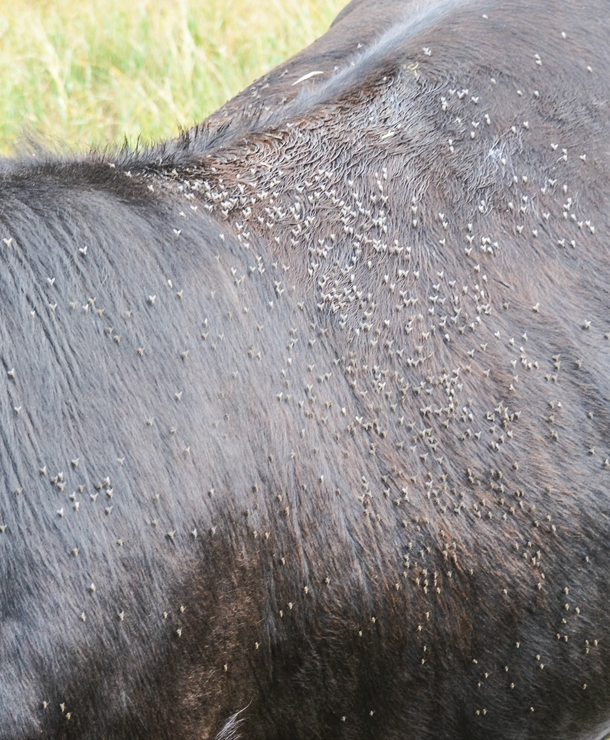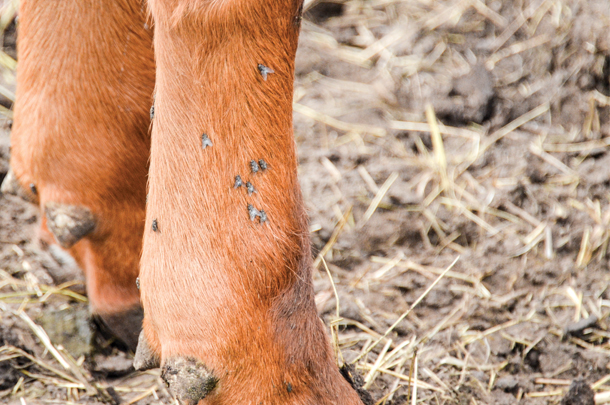There are three fly species of major importance that economically impact pastured cattle: the horn fly, face fly and stable fly.
The horn fly
Horn flies are about 3/16 of an inch in length and are normally found on the backs, sides and poll areas of cattle. During the warm part of the day, horn flies can be seen on the belly area of cattle.

The horn fly feeds on blood, with both male and female flies acquiring more than 30 blood meals per day. After mating, the female fly will leave the animal to deposit eggs in fresh cattle manure.
Eggs hatch within one week, and larvae feed and mature in the manure, pupating in the soil beneath the manure pat. Newly emerged horn flies can travel several miles searching for a host. The entire life cycle can be completed in 10 to 20 days depending on the weather.
Economic losses associated with horn flies are estimated at more than $1 billion annually in the U.S. Horn fly feeding causes irritation, blood loss, decreased grazing efficiency, reduced weight gains and a decline in milk production. Furthermore, horn flies have been implicated in the spread of summer mastitis.
U.S. and Canadian studies have shown horn flies can inflict weight gain losses in cattle, and calf weaning weights can be negatively impacted from 4 to 15 percent. Nebraska studies have demonstrated calf weaning weights were 10 to 20 pounds higher when horn flies were controlled on mother cows.
The economic injury level (EIL) for horn flies is 200 flies per animal. Yearling cattle can also be impacted by the horn fly; other studies have indicated yearling weight can be reduced by as much as 18 percent.
There are many chemical methods available to reduce horn fly numbers: backrubbers, dust bags, insecticidal eartags/cattle strips, pour-ons, oral larvicides, low-pressure/mist-blower sprayers and the VetGun.
Insecticide eartags/cattle strips are a convenient method of horn fly control. However, many horn fly populations exhibit a low to moderate degree of resistance to the pyrethroid class of insecticides. The recommended management practice to maintain horn fly control efficacy in your pastures is to rotate insecticide classes.
Recently, a new class of insecticide (Tolfenpyrad) has been approved for use as an insecticide eartag. Backrubbers and dust bags are an effective way to reduce horn fly numbers if cattle are forced to use them. Sprays and pour-ons can provide seven to 21 days of control and will need to be repeated for season-long control.
Oral larvicides prevent fly larvae from developing into adults. An important factor when using an oral larvicide is ensuring steady consumption. A complicating issue when using an oral larvicide is that of horn fly immigration from neighboring untreated herds, which can mask the effectiveness of an oral larvicide. The VetGun applies an individual capsule of insecticide to an animal and can provide control between 21 and 35 days.
The face fly
Face flies closely resemble house flies – except they are slightly larger and darker than the house fly. The face fly is a non-biting fly that feeds on animal secretions, nectar and dung liquids. The adult female face flies clustering around an animal’s eyes, mouth and muzzle can cause extreme annoyance (see top photo).
Face flies will also feed on blood and other secretions around wounds caused by mechanical damage or other injury. Face flies are present throughout the summer, but populations usually peak in late July and August. Face flies are most numerous along waterways, areas with abundant rainfall, canyon floors with trees and shaded vegetation and on irrigated pastures.
Female face fly feeding causes damage to eye tissues, increases susceptibility to eye pathogens and vector Moraxella bovis, the causal agent of pinkeye or infectious bovine keratoconjuctivitis.
Pinkeye is a highly contagious inflammation of the cornea and conjunctiva of cattle. If coupled with the infectious bovine rhinotracheitis (IBR) virus, M. bovis can cause a much more severe inflammatory condition. Controlling face flies is essential in reducing most pinkeye problems.
Achieving adequate face fly control can be difficult because of their habit of feeding around the face and the significant time they spend off the animal. Control is maximized when cattle receive daily insecticide applications by either dust bags, oilers, sprays or an insecticide-impregnated eartag/strip. Eartags/strips should be applied at the label-recommended rate. Both cows and calves must be treated if control is to be achieved.
Pinkeye vaccines are available and should be considered if face flies and pinkeye have been a recurring problem. Currently, commercial and autogenous pinkeye vaccines are available; please check with your local veterinarian about the use of these products in your area.
The stable fly
Stable flies are serious pests of feedlots, dairies and pastured cattle. The stable fly is a blood feeder, mainly feeding on the front legs of cattle, staying on the animal long enough to complete a blood meal. Their bite is very painful; cattle will often react by stomping their legs, bunching at pasture corners or stand in water to avoid being bitten.

Stable flies cause similar weight gain losses to both pasture and confinement cattle. University of Nebraska research recorded a reduction in average daily gain of 0.44 pounds per head with animals which received no insecticide treatment compared to animals which received a treatment.
The economic threshold of five flies per leg is easily exceeded in Nebraska pastures.
The female stable fly deposits eggs in spoiled or fermenting organic matter mixed with animal manure, soil and moisture. The most common developing sites are in feedlots or dairy lots, usually around feedbunks, along the edges of feeding aprons, under fences and along stacks of hay, alfalfa and straw. Grass clippings and poorly managed compost piles also may be stable fly-developing sites.
Winter hay feeding sites where hay rings are used can often be a source for larval development through the summer if the proper moisture is present. The life cycle of the stable fly can take 14 to 24 days depending on weather conditions. While the source of early season stable flies on pastured cattle is not well understood, some probably develop from overwintering larvae.
Other early season flies may be migrants from southern locations, but evidence is lacking. Nevertheless, we do know stable flies can move at least 10 miles or more.
The only adult management option available for the control of stable flies on range cattle is use of on-animal sprays. Sprays can be applied using a low-pressure sprayer or can be applied with a mist-blower sprayer. Weekly applications of these products will be required to achieve reduction in fly numbers.
Sanitation or cleanup of wasted feed at winter feeding sites may reduce localized fly development. If sanitation is not possible these sites may be treated with a larvicide (Neporex). But the application of either procedure may not totally reduce the economic impact of stable fly feeding. ![]()
For current Nebraska control recommendations, check EC1550, Nebraska Management Guide for Insect Pests of Livestock and Horses .
PHOTO 1: Face flies on cows.
PHOTO 2: Horn flies on animal located on typical areas of back and side.
PHOTO 3: Stable flies feeding on leg of animal. Photos courtesy of University of Nebraska-Lincoln Extension.

-
Dave Boxler
- Extension Educator – Entomology
- University of Nebraska West Central Research and Extension Center
- Email Dave Boxler








